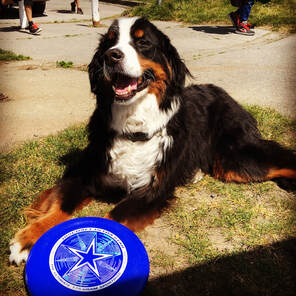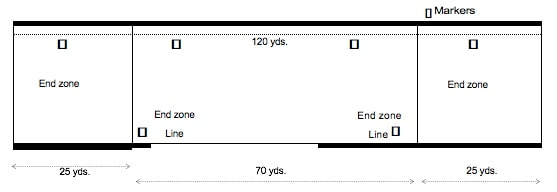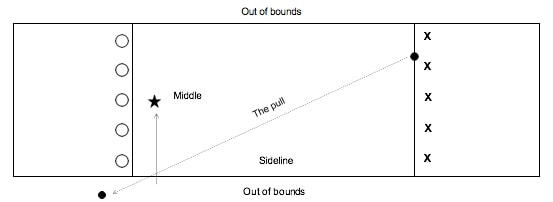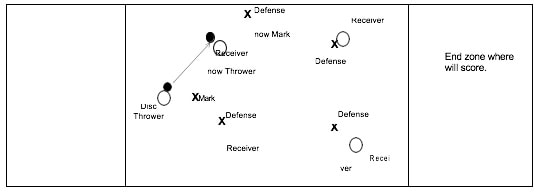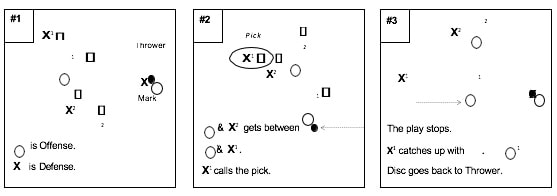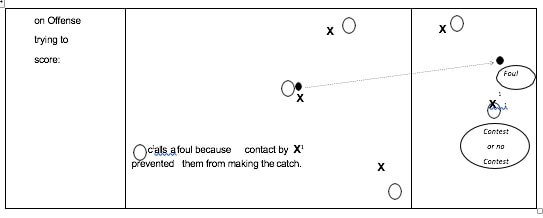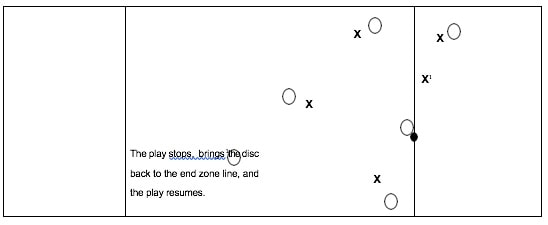SESAA Ultimate
Welcome to the SESAA Ultimate information site. You will find some helpful information on this site to help you with your season.
THE FIELD
A rectangular shape with end zones at each end. A regulation field is 70 yards by 40 yards, with end zones 25 yards deep.
INITIATE PLAY
Each point begins with both teams lining up on the front of their respective end zone line. The defense throws ("pulls") the disc to the offense. A regulation game has seven players per team, with a gender split of 4 boys and 3 girls or 4 girls and 3 boys.
SCORING
Each time the offense completes a pass in the defense's end zone, the offense scores a point. Play is initiated after each score, with the team scoring the point “pulling” the disc from the end zone where the point was scored. The team scored upon then defends the end zone at the opposite end.
MOVEMENT OF THE DISC
The disc may be advanced in any direction by completing a pass to a teammate. Players may not run with the disc. The person with the disc ("thrower") has ten seconds to throw the disc. The defender guarding the thrower ("marker") counts out the stall count.
CHANGE OF POSSESSION
When a pass is not completed (e.g. out of bounds, drop, block, interception), the defense immediately takes possession of the disc and becomes the offense.
SUBSTITUTIONS
Players not in the game may replace players in the game after a score and during an injury timeout.
NON-CONTACT
No physical contact is allowed between players. Picks and screens are also prohibited. A foul occurs when contact is made.
FOULS
When a player initiates contact on another player a foul occurs. When a foul disrupts possession, the play resumes as if the possession was retained. If the player committing the foul disagrees with the foul call, the play is redone.
SELF-REFEREEING
Players are responsible for their own foul and line calls. Players resolve their own disputes.
SPIRIT OF THE GAME
Ultimate stresses sportsmanship and fair play. Competitive play is encouraged, but never at the expense of respect between players, adherence to the rules, and the basic joy of play.
ULTIMATE CELEBRATION PLAY DAY FORMAT
More details will follow regarding the Celebration Play Day format and schedule. The tournament will highlight all the teams and will give us a chance to possibly even watch two high schools or university teams play.
GAME FUNDAMENTALS
Ultimate is a relatively easy game to learn and to teach. The equipment needed is minimal: A number of (preferably 175 gram) discs (Frisbees), field markers, shoes with plastic cleats (optional), pinnies (to tell the teams apart), and players. The field size is officially 40 yards (or strides) wide and 120 yards long, which includes the two 25 yard end zones, (but then (almost) everything about Ultimate is flexible).
A rectangular shape with end zones at each end. A regulation field is 70 yards by 40 yards, with end zones 25 yards deep.
INITIATE PLAY
Each point begins with both teams lining up on the front of their respective end zone line. The defense throws ("pulls") the disc to the offense. A regulation game has seven players per team, with a gender split of 4 boys and 3 girls or 4 girls and 3 boys.
SCORING
Each time the offense completes a pass in the defense's end zone, the offense scores a point. Play is initiated after each score, with the team scoring the point “pulling” the disc from the end zone where the point was scored. The team scored upon then defends the end zone at the opposite end.
MOVEMENT OF THE DISC
The disc may be advanced in any direction by completing a pass to a teammate. Players may not run with the disc. The person with the disc ("thrower") has ten seconds to throw the disc. The defender guarding the thrower ("marker") counts out the stall count.
CHANGE OF POSSESSION
When a pass is not completed (e.g. out of bounds, drop, block, interception), the defense immediately takes possession of the disc and becomes the offense.
SUBSTITUTIONS
Players not in the game may replace players in the game after a score and during an injury timeout.
NON-CONTACT
No physical contact is allowed between players. Picks and screens are also prohibited. A foul occurs when contact is made.
FOULS
When a player initiates contact on another player a foul occurs. When a foul disrupts possession, the play resumes as if the possession was retained. If the player committing the foul disagrees with the foul call, the play is redone.
SELF-REFEREEING
Players are responsible for their own foul and line calls. Players resolve their own disputes.
SPIRIT OF THE GAME
Ultimate stresses sportsmanship and fair play. Competitive play is encouraged, but never at the expense of respect between players, adherence to the rules, and the basic joy of play.
ULTIMATE CELEBRATION PLAY DAY FORMAT
More details will follow regarding the Celebration Play Day format and schedule. The tournament will highlight all the teams and will give us a chance to possibly even watch two high schools or university teams play.
- District hosts tournament
- Run from 12:30:00-5:00 pm
- All schools at a venue
- 1st place team rosette
- 1st, 2nd, 3rd place bracelets for corresponding competitive tournament winners
- All other athletes receive a participation bracelet
- 4 - 3 gender split for play
GAME FUNDAMENTALS
Ultimate is a relatively easy game to learn and to teach. The equipment needed is minimal: A number of (preferably 175 gram) discs (Frisbees), field markers, shoes with plastic cleats (optional), pinnies (to tell the teams apart), and players. The field size is officially 40 yards (or strides) wide and 120 yards long, which includes the two 25 yard end zones, (but then (almost) everything about Ultimate is flexible).
Each game begins with the teams (officially 7 players, but again this is flexible - five is better for beginning players) lining up on their end zone line. Each defensive team member chooses the one offensive player they will defend against for the duration of the point, wait to see a raised hand from the offensive team (signalling that they are ready to begin), and then 'pull' the disc down the field (similar to the kickoff in football).
If the pull ends up out-of-bounds the offensive team has the option of playing it from the sideline where it went out, or the middle of the field parallel to the point where it went out.
One member of the offensive team (it doesn't matter who) catches or picks up the pulled disc and begins to move the disc downfield (from where it came) to score in the opposite end zone. This movement involves throwing the disc to an open receiver (any other member of their team) who upon catching the disc stops running, establishes a pivot foot (as in basketball), and becomes the new thrower. Unless you are playing a zone, there are no positions in Ultimate, meaning that the thrower can pass to any receiver anywhere on the field.
During play each defensive player is trying to create a turn-over, (preventing their offensive 'partner' from catching or throwing the disc). In Ultimate there is no physical contact between players, the defense must either cover the player effectively enough to stop them from becoming an open receiver, or knock/catch the disc out of the air before the receiver has control of the disc (having the disc firmly in their hand). Any time the defense is successful in knocking down/catching the disc it is a turn-over. This means that the defense becomes the offense and begins immediately moving the disc down the field, in the opposite direction (from the point of the turn-over), to score in the other end zone.
The 'mark', the player whose defensive partner is now the thrower, must stand at least a disc length from the thrower, (all other defensive players must be at least 10 feet from the thrower), and be careful not to straddle the thrower's leg. The mark must also call out the 'count' as soon as the thrower has established their pivot foot. The stall count shall be at a reasonable pace: “1 stall, 2 stall, 3 stall…10 stall.” If the mark gets to the “stall” in “10 stall,” it is a turn-over.
Besides intercepting the disc in the air or a ten count, the disc is considered turned-over if it hits the ground, is thrown out-of-bounds (the line is considered out), or the receiver catches it out-of-bounds (the first point of the receiver's body) to contact the ground will determine whether they are out).
Part of the Spirit of the Game is the calling of fouls. Each player is responsible for calling their own fouls, both those made against, and caused by, themselves. There are no refs in Ultimate, not even at the World Championships!
Besides intercepting the disc in the air or a ten count, the disc is considered turned-over if it hits the ground, is thrown out-of-bounds (the line is considered out), or the receiver catches it out-of-bounds (the first point of the receiver's body) to contact the ground will determine whether they are out).
Part of the Spirit of the Game is the calling of fouls. Each player is responsible for calling their own fouls, both those made against, and caused by, themselves. There are no refs in Ultimate, not even at the World Championships!
- Any contact, even if unintentional, is a foul. If the two players concerned disagree that a foul was committed (the second player 'contesting' the foul called by the first) then the play is redone - the disc going back to the thrower (who does not have to throw it back to the same receiver). If the foul call is not contested, the receiver keeps the disc and the play continues.
- If the mark makes contact with the disc while it is still in the thrower's hand, it is also considered a contact foul. If it is uncontested the count goes back to zero. If the foul is contested, the count begins either at the point it was at when the foul was called (if below "stall five"), or coming in at "stall six" (if above "stall five").
- The 'pick' when any player gets in between an offensive receiver and their defensive partner, is also a foul. If a pick is called, the defensive player who was picked is allowed to catch-up to their offensive partner. If the pick was called after the disc was thrown, and before it was subsequently caught, the disc goes back to the thrower and the count resumes where it left off, unless it was above stall five, in which case if comes in at "stall six." Similarly, if the disc is thrown after the pick call, the disc goes back to the thrower, except if the pass is incomplete (not caught), in which case it is a turnover.
A 'travel', when the offensive receiver (now thrower) doesn't establish, or moves, their pivot foot during the time they have possession of the disc, is a foul. When a travel is called, both the disc and the count go back to the thrower at the point where the travel began.
Another foul is the 'strip'. This is when the offensive player has control of the disc yet the defensive player knocks it out of their hand. The stripped disc remains in the possession of the player who had the disc at the point where the strip took place.
Whenever a foul is called, (or the disc goes out of bounds), causing a stoppage in play, the disc must be 'checked in' before play can resume. This means that the mark, as soon as the rest of the defense is ready, counts aloud "three, two, one, disc in" and the play begins again.
For all uncontested fouls in the end zone, the disc is brought back to the end zone line at the point parallel to where the foul took place. All other calls, ("out-of-bounds," "down" which means the disc touched the ground before it was caught and whether or not a receiver had control of the disc) are made by the receiver, or, if they cannot honestly make the call, by those in the best position to judge.
Another foul is the 'strip'. This is when the offensive player has control of the disc yet the defensive player knocks it out of their hand. The stripped disc remains in the possession of the player who had the disc at the point where the strip took place.
Whenever a foul is called, (or the disc goes out of bounds), causing a stoppage in play, the disc must be 'checked in' before play can resume. This means that the mark, as soon as the rest of the defense is ready, counts aloud "three, two, one, disc in" and the play begins again.
For all uncontested fouls in the end zone, the disc is brought back to the end zone line at the point parallel to where the foul took place. All other calls, ("out-of-bounds," "down" which means the disc touched the ground before it was caught and whether or not a receiver had control of the disc) are made by the receiver, or, if they cannot honestly make the call, by those in the best position to judge.
If uncontested:
A goal is scored when the offense throws the disc to one of their receivers already in the end zone. The player cannot run the disc into the end zone. If they do they must take the disc back to the point outside the end zone where it was caught and throw it to another receiver who is already in. If the disc is turned-over in the end zone, or goes out-of-bounds at any point, the defensive (now turned offensive) players may bring the disc up to the end zone line or sideline parallel to the point of the turn-over. Once a goal is scored each team lines up on the opposite end zone line from the one they were on previously - changing sides every point. A goal is considered one point, and a game typically goes to anywhere from 11 to 21 points (always an odd number).
By Letitia Lipp B. Ed.
By Letitia Lipp B. Ed.
Official Rules of the Game
| usau11thed.pdf | |
| File Size: | 993 kb |
| File Type: | |
Foul Guide
| fouls%20-%20quick%20guide.pdf | |
| File Size: | 80 kb |
| File Type: | |
